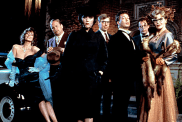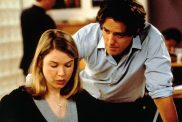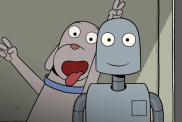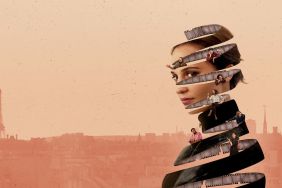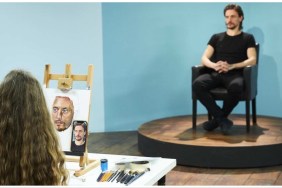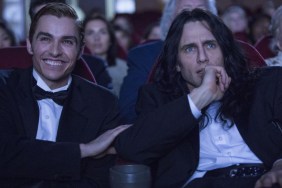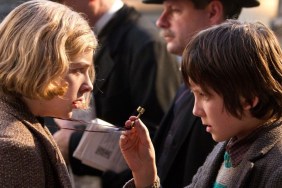“Hugo” Cast:
Sir Ben Kingsley as Georges Méliès
Sacha Baron Cohen as Station inspector
Asa Butterfield as Hugo Cabret
Chloë Grace Moretz as Isabelle
Ray Winstone as Uncle Claude
Emily Mortimer as Lisette
Christopher Lee as Monsieur Labisse
Helen McCrory as Mama Jeanne
Michael Stuhlbarg as Rene Tabard
Frances de la Tour as Madame Emilie
Richard Griffiths as Monsieur Frick
Jude Law as Hugo’s Father
Kevin Eldon as Policeman
Directed by Martin Scorsese
“The Artist” Cast:
Jean Dujardin as George Valentin
Bérénice Bejo as Peppy Miller
John Goodman as Zimmer
Bitsie Tulloch as Norma
Missi Pyle as Constance
Penelope Ann Miller as Doris
James Cromwell as Clifton
Andy Milder as Director
Beth Grant as Peppy’s Maid
Ed Lauter as The Butler and The Distinguished Gentleman
Joel Murray as Police Officer Fire
Ben Kurland as Casting Assistant
Stuart Pankin as Otto / Director #1
Ken Davitian as Pawn Broker
Patrick Mapel as Director’s Assistant
Directed by Michel Hazanavicius
Review:
No, this isn’t really another “versus” review as the title states–we already know how much you all hate them–but rather, this is our look at two movies that complement each other so well they offer one of the best potential double features of the year. Though they’re both period pieces set around the late ’20s, they’re very different movies, both acting as love letters to the silent film era and how influential those movies have been for everything that’s come since then.
Based on Brian Selznck’s novel, Martin Scorsese’s “Hugo” is a loving tribute to the silent movie era disguised as a kiddie film, while “OSS 117” mastermind Michel Hazanavicius goes one step better by actually making a bonafide silent film, in black and white no less. The irony of one of America’s greatest filmmakers telling a story about the French silent film era, at the same time as a French filmmaker glorifying Hollywood during the transition between silent movies and “talkies” offers an opportunity to contrast two movies that’s too great to pass up.
The title character of “Hugo” is a young boy named Hugo Cabret, played by Asa Broomfield (“The Boy in the Striped Pajamas”), who lives in the clockworks of the bustling Paris train station and has been working on fixing a broken automaton left to him by his late father (Jude Law). His quest for mechanical parts puts him at odds with a local shopkeeper (Sir Ben Kingsley), who threatens to turn Hugo over to the station inspector (Sacha Baron Cohen) but sees talent in the boy and puts him to work as penance for his thefts.
“The Artist” begins with its leading man George Valentin (Jean Dujardin) in an electric chair refusing to speak as he’s being tortured, an attitude he’ll mirror for the remainder of the film, and the brilliance of Hazanavicius’ film is realized from the moment you realize you’re watching a honest-to-gosh silent movie, realized when it’s revealed that opening scene is a movie being watched by an audience who voice their approval with silent applause. Signing autographs outside after the movie, Valentin literally bumps into Peppy Miller (Bérénice Bejo), one of his biggest fans, and they have such great chemistry, the trades eat it up, putting Miller on the cover. Peppy is clearly a star in the making, and the film is essentially a two-pronged “A Star is Born” story following Peppy’s rise, just as Valentin’s refusal to accept the idea of “talking movies” starts to turn his own career sour.
“The Artist” offers immediate pleasure in its maintaining of its conceit to use many tricks of the trade from movies of that era. It’s a novelty for sure, but it’s one that works because there’s a central story worth telling regardless of the format. It takes quite a bit more time before “Hugo” presents itself as anything beyond other kid fantasy fare adapted from a popular book, but from the opening tracking shot across Paris at night, Scorsese has created a lush and gorgeous film that takes full advantage of the 3D technology to explore every nook and cranny of Dante Ferreti’s fantastic train station set. It’s one of the first movies since “Avatar” that absolutely must be experienced in 3D.
Possibly the biggest hurdle “Hugo” has to overcome is that much of its first hour is spent with the younger actors, Asa Butterfield and Chloë Moretz, both giving the type of saccharine kiddie performances we’ve seen in far too many movies, most of them starring a younger Freddie Highmore. Both young actors have done better work, making it obvious how out of his comfort zone Scorsese is working with them while also creating something that will keep adults on board.
Hazanavicius has the benefits of two great leads and a far more unconventional cast with Jean DuJardin perfectly embodying the silent film stars of the swashbuckler variety ala Douglas Fairbanks. It’s a very different performance from his portrayal of a clueless spy in Hazanavicius’ “OSS 117” movies, one that’s far more layered and never held back by his lack of words. Bejo is the perfect counterpart as the two of them establish a different type of love story, one that’s never consummated, but one that truly makes you feel as if you’re watching what must have been happening in Hollywood as sound was added to movies. Sacha Baron Cohen’s Gustav the Station Inspector in “Hugo” may as well be cut from the same cloth as Hazanavicius’ leads, being patterned after some of the villains of the silent film era, using facial expressions in such a perfect way to embellish the terrific dialogue he’s working with.
Both films benefit greatly from the smaller supporting roles like Christopher Lee, Michael Stuhlbarg, Richard Griffiths, Emily Mortimer and Frances de la Tour as the characters Hugo encounters on his adventure. John Goodman is terrific as the head of the studio in “The Artist,” as is James Cromwell as Valentin’s fateful driver and butler who sticks with him through the lean years; both actors seem tailor-made for silent movies.
Neither film would work if not for their gorgeous scores, and that’s particularly the case with “The Artist” and its lack of dialogue, but Howard Shore absolutely has outdone himself with his score for “Hugo” which recreates the music of the time but also helps to evoke every ounce of emotion possible.
“The Artist” does lag in its second act as we generally know the trajectories of its stars and the novelty starts to lose some luster, because from there, it’s just a matter of seeing how things will resolve. Where “Hugo” really shines is its transition from second to third act as Hugo discovers the secret behind the automaton (and at this point, we’ll insert a thoughtful SPOILER WARNING in case you haven’t read the book) which points to the true identity of “Papa Georges” Méliès, the crotchety shop owner with a secret past. This last act is elevated by an incredibly moving performance by Sir Ben Kingsley as Méliès, and while being discovered by a young orphan in a train station is fictionalized fantasy, the fact Scorsese and his team were able to use that as their entry into the world of silent film is brilliant and it would never have worked if not for Kingsley’s unforgettable performance in that last act.
We could talk at length about that third act as it’s just so wonderful and perfect, but hopefully, those reading this will have the wherewithal to Google the name and learn about his contribution to cinema. For kids, it will be a painless lesson in film history that might make them more interested in silent films. One could also say the same for “The Artist.” Although some of the subtleties may be lost on younger kids, there’s a universality to the telling of the story that can appeal to kids over 10 or 11 in a same was as movies starring Chaplin, Keaton or Harold Lloyd.
The Bottom Line:
“The Artist” is a joyous crowd-pleasing movie that pays homage to the great silent film era in a clever way that offers multiple layers. “Hugo” takes a bit longer to pull you into its world but leaves you fully satisfied with the experience. One marks the rise of a talented French filmmaker by doing something different, while the other has one of America’s greatest filmmakers paying tribute to a French filmmaker whose groundbreaking work made both films possible.
If you don’t live in New York or Los Angeles, where “The Artist” is opening on Friday, then “Hugo” is your best bet, but if you live in either city, this is one of the best double features of the year, and both films should play well with kids 10 and up.
Hugo: 8/10 Rating
The Artist: 8.5/10 Rating

